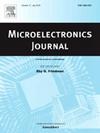Inductance-assisted high bandwidth avalanche photodiode based on hybrid genetic algorithm
IF 1.9
3区 工程技术
Q3 ENGINEERING, ELECTRICAL & ELECTRONIC
引用次数: 0
Abstract
This paper proposes and fabricates an inductance-assisted high bandwidth avalanche photodiode (APD) based on hybrid genetic algorithm (HGA) optimization design. The APDs and meandering electrodes were accurately modeled and optimized using equivalent circuit models and HGA. The measured results of the fabricated 26 μm and 42 μm APDs demonstrate bandwidth enhancement at each gain with the help of the HGA-based meandering electrodes. The gain-bandwidth products of the two types of APDs are 306 GHz and 119 GHz, respectively. With a gain of 2.15, the bandwidths of the 26 μm and 42 μm APDs increased from 10.3 GHz to 5.5 GHz–19.5 GHz and 10.1 GHz, respectively, representing a bandwidth extension of over 90 %. The measurement results closely match the algorithm optimization results, validating the reliability of the design method. Compared to three other optimization algorithms, HGA exhibits ultra-fast convergence speed and superior optimization results. This paper provides a novel and reliable method for designing high-performance APDs, offering valuable insights for enhancing the bandwidth of optoelectronic devices.
基于混合遗传算法的电感辅助高带宽雪崩光电二极管
提出并制作了一种基于混合遗传算法优化设计的电感辅助高带宽雪崩光电二极管(APD)。利用等效电路模型和HGA对apd和弯曲电极进行了精确建模和优化。在26 μm和42 μm apd的测量结果表明,在基于hga的弯曲电极的帮助下,每个增益的带宽都有所提高。两种apd的增益带宽乘积分别为306 GHz和119 GHz。增益为2.15时,26 μm和42 μm apd的带宽分别从10.3 GHz增加到5.5 GHz - 19.5 GHz和10.1 GHz,带宽扩展超过90%。实测结果与算法优化结果吻合较好,验证了设计方法的可靠性。与其他三种优化算法相比,HGA具有超快的收敛速度和优越的优化效果。本文为高性能apd的设计提供了一种新颖可靠的方法,为提高光电器件的带宽提供了有价值的见解。
本文章由计算机程序翻译,如有差异,请以英文原文为准。
求助全文
约1分钟内获得全文
求助全文
来源期刊

Microelectronics Journal
工程技术-工程:电子与电气
CiteScore
4.00
自引率
27.30%
发文量
222
审稿时长
43 days
期刊介绍:
Published since 1969, the Microelectronics Journal is an international forum for the dissemination of research and applications of microelectronic systems, circuits, and emerging technologies. Papers published in the Microelectronics Journal have undergone peer review to ensure originality, relevance, and timeliness. The journal thus provides a worldwide, regular, and comprehensive update on microelectronic circuits and systems.
The Microelectronics Journal invites papers describing significant research and applications in all of the areas listed below. Comprehensive review/survey papers covering recent developments will also be considered. The Microelectronics Journal covers circuits and systems. This topic includes but is not limited to: Analog, digital, mixed, and RF circuits and related design methodologies; Logic, architectural, and system level synthesis; Testing, design for testability, built-in self-test; Area, power, and thermal analysis and design; Mixed-domain simulation and design; Embedded systems; Non-von Neumann computing and related technologies and circuits; Design and test of high complexity systems integration; SoC, NoC, SIP, and NIP design and test; 3-D integration design and analysis; Emerging device technologies and circuits, such as FinFETs, SETs, spintronics, SFQ, MTJ, etc.
Application aspects such as signal and image processing including circuits for cryptography, sensors, and actuators including sensor networks, reliability and quality issues, and economic models are also welcome.
 求助内容:
求助内容: 应助结果提醒方式:
应助结果提醒方式:


